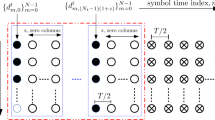Abstract
Filter bank multi-carrier (FBMC) is an emerging 5G technology due to its finer spectral characteristics than its counterpart orthogonal frequency-division multiplexing (OFDM). In most cases, FBMC is united with an Offset Quadrature Amplitude modulation (OQAM) for individual sub-carrier to maximize the spectrum efficiency and Nyquist rate. But it is achieved at the cost of an inherent accumulative imaginary interference called intrinsic interference. When a channel is highly selective, the FBMC system undergoes inter-symbol-interference (ISI) and co-channel interference (CCI). In this research, we consider FBMC QAM as a solution to intrinsic interference and mitigates both ISI and CCI by incorporating ML equivalent signal detection. In this paper, some of the prominent issues related to the existing FBMC–OQAM are explored and its potential integrity constraints with existing MIMO and signal detection techniques are studied. In addition to that, a lightweight optimized ML which constitutes parallel sub-detectors with the least hardware complexity overhead is proposed. It also achieved a near-optimal performance that matches the CP-OFDM system. In this research, the experimental results proved that the proposed suboptimal ML detector offered significant complexity reduction with improved quality of services. Thus evidently shows the proposed system is attractive from both BER performance and hardware complexity reduction perspectives for 5G communications.






Similar content being viewed by others
References
Li, Y. G., Winters, J. H., & Sollenberger, N. R. (2002). MIMO-OFDM for wireless communications: signal detection with enhanced channel estimation. IEEE Transactions on Communications, 50(9), 1471–1477.
Xu, M., et al. (2016). FBMC in next-generation mobile fronthaul networks with centralized pre-equalization. IEEE Photonics Technology Letters, 28(18), 1912–1915.
Zakaria, R., & Le Ruyet, D. (2012). A novel filter-bank multicarrier scheme to mitigate the intrinsic interference: Application to MIMO systems. IEEE Transactions on Wireless Communications, 11(3), 1112–1123.
Kofidis, E., & Katselis, D. (2011). Improved interference approximation method for preamble-based channel estimation in FBMC/OQAM. In 2011 19th European signal processing conference. IEEE.
Lin, H. (2015). Flexible configured OFDM for 5G air interface. IEEE Access, 3, 1861–1870.
Yu, B., et al. (2016). Channel estimation using dual-dependent pilots in FBMC/OQAM systems. IEEE Communications Letters, 20(11), 2157–2160.
Rezazadeh Reyhani, A., & Farhang-Boroujeny, B. (2017). An analytical study of circularly pulse-shaped FBMC–OQAM waveforms. IEEE Signal Processing Letters, 24(10), 1503–1506.
Ihalainen, T., et al. (2011). Channel equalization for multi-antenna FBMC/OQAM receivers. IEEE Transactions on Vehicular Technology, 60(5), 2070–2085.
Zhao, Z., Vucic, N., & Schellmann, M. (2014). A simplified scattered pilot for FBMC/OQAM in highly frequency selective channels. In 2014 11th international symposium on wireless communications systems (ISWCS). IEEE.
Cheng, Y., Li, P., & Haardt, M. (2014). Intrinsic interference mitigating coordinated beamforming for the FBMC/OQAM based downlink. EURASIP Journal on Advances in Signal Processing, 2014(1), 86.
Choi, J.-M., et al. (2017). Pilot-aided channel estimation utilizing intrinsic interference for FBMC/OQAM systems. IEEE Transactions on Broadcasting, 63(4), 644–655.
Mo, J., & Heath, R. W. (2015). Capacity analysis of one-bit quantized MIMO systems with transmitter channel state information. IEEE Transactions on Signal Processing, 63(20), 5498–5512.
Nissel, R., & Rupp, M. (2017). OFDM and FBMC–OQAM in doubly-selective channels: Calculating the bit error probability. IEEE Communications Letters, 21(6), 1297–1300.
Kwon, B., et al. (2016). Iterative interference cancellation and channel estimation in evolved multimedia broadcast multicast system using filter-bank multicarrier-quadrature amplitude modulation. IEEE Transactions on Broadcasting, 62(4), 864–875.
Zakaria, R., & Le Ruyet, D. (2014). Intrinsic interference reduction in a filter bank-based multicarrier using QAM modulation. Physical Communication, 11, 15–24.
Sim, D., & Lee, C. (2017). A MIMO receiver with two-dimensional ordering for maximum likelihood detection in FBMC–QAM. IEEE Communications Letters, 21(7), 1465–1468.
Kwon, B., & Lee, S. (2018). Cross-antenna interference cancellation and channel estimation for MISO-FBMC/QAM-based eMBMS. Wireless Networks, 24(8), 3281–3293.
Lee, T., et al. (2018). Channel estimation scheme in the oversampled frequency domain for FBMC–QAM systems based on the prototype filter set. IEEE Transactions on Vehicular Technology, 68(1), 728–739.
Castaneda, O., Goldstein, T., & Studer, C. (2016). FPGA design of approximate semidefinite relaxation for data detection in large MIMO wireless systems. In IEEE international symposium on circuits and systems (ISCAS). IEEE.
Author information
Authors and Affiliations
Corresponding author
Additional information
Publisher's Note
Springer Nature remains neutral with regard to jurisdictional claims in published maps and institutional affiliations.
Rights and permissions
About this article
Cite this article
Subalatha, M., Jayashri, S., Raja, J. et al. Low Complexity Maximum Likelihood FBMC QAM for Improved Performance in Longer Delay Channels. Wireless Pers Commun 117, 3051–3066 (2021). https://doi.org/10.1007/s11277-020-07427-7
Published:
Issue Date:
DOI: https://doi.org/10.1007/s11277-020-07427-7




